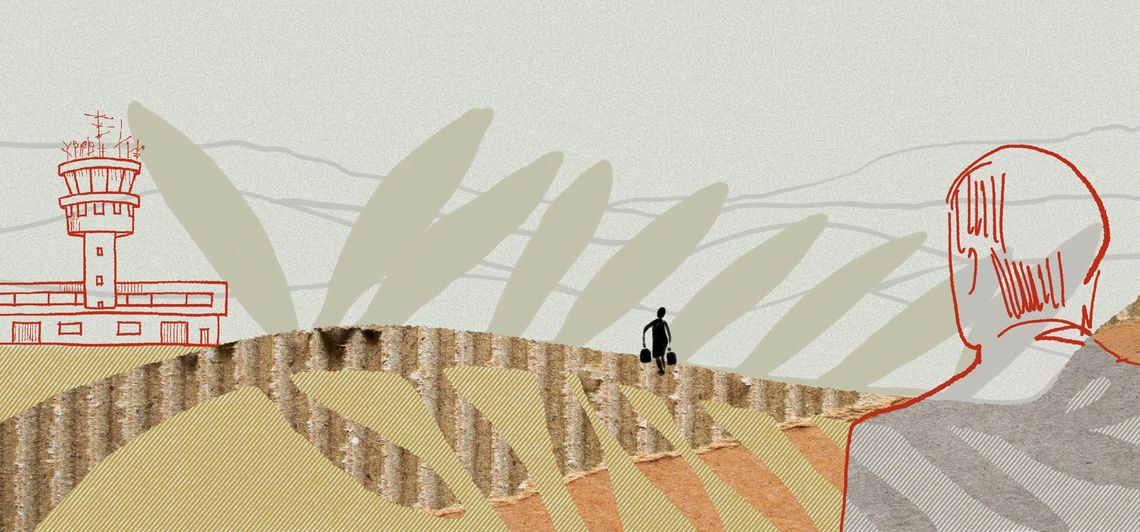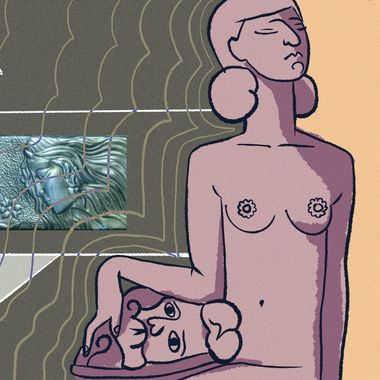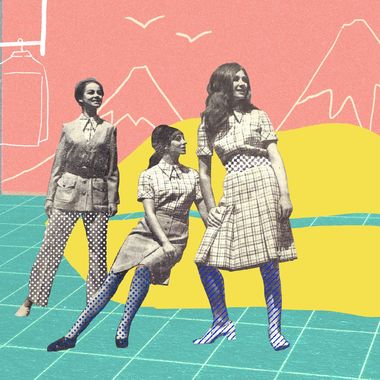Tue Jun 08 2021 · 7 min read
Did the Wind Drop? Nora Martirosyan's Optimistic Drama From Artsakh

By Sona Karapoghosyan

Illustration by Armine Shahbazyan.
When the COVID-19 pandemic began impacting international travel and triggering lockdowns, it became clear that the Cannes Film Festival, scheduled for May 2020, would not take place in its usual format. After being postponed and then restructured, the festival's artistic staff put forward the concept of Cannes Label, which would be awarded to the 56 films selected for the festival, to contribute to their future distribution. These films were not distributed into the Competition or Out of Competition sections, and so they were on equal footing. To the delight of all Armenian cinematographers, among them was Nora Martirosyan's feature film "Should the Wind Drop," which was the first film from Armenia to be screened in Cannes after the proclamation of the Third Republic of Armenia. During the Soviet years, only Frunze Dovlatyan had achieved such success with his drama "Hello, It’s Me!" (1965).[1]
The film revolves around the Artsakh airport. Built in the 1970s and actively operated during the Soviet era, the airport ceased to function following the First Karabakh War. In 2012, it was completely renovated, but was never officially reopened due to political reasons. Being in an unrecognized republic, the airport could not qualify for international flights. The Azerbaijani side did not facilitate the situation either; the country's high-ranking officials threatened to open fire on planes entering the airspace of Artsakh. Director Nora Martirosyan’s film reveals the frustrating situation surrounding the airport as a starting point to delve into the history, problems and spirit of Artsakh.
In the film, French specialist Alain Delange arrives in Stepanakert to assess the airport and submit a report to his management, on which the future operation of the airport will depend. The entire course of the film is built as a revelation of Artsakh and its local population through the eyes of this foreigner. With simple script solutions, the director presents Artsakh’s past—oral stories about the First Karabakh War, pictures of heroes killed in the war hanging from the walls, the image of a former soldier gone mad—and gives a sense of the country’s military presence in the city, the general fighting spirit and readiness to start a war at any given second, and even the willingness to do so. Several scenes convey the locals' view of young men or boys—they were born to be soldiers and to serve, to fight for Artsakh. Although the future of the country is uncertain, the director tries to remain optimistic, believing in the diligence and willpower of its people. Added to all this are the Artsakhian, and in general Armenian, socio-cultural components: a scene from Vardavar, a reception, a discussion about Artsakhian vodka…
One of the main characteristics of "Should the Wind Drop" is the system of multi-layered symbols and allegories in the film. In one of her interviews, Martirosyan mentions that the airport itself is a symbol; it symbolizes Artsakh, which is not yet ready to fly. The young protagonist of the film, Edgar, carries water from the airport and sells it to the residents of Stepanakert, saying that it is from a sacred spring. The impression is that this water feeds all the ideas and hopes that the locals have concerning the operation of the Artsakh airport. They rightly believe that, by having it operational, the country will be able to connect with the outside world and stop suffocating within its unrecognized borders. The director of the airport regularly talks about this with the foreign auditor, Alain Delange, expecting his help in the form of a positive report.
The relations of the director and the auditor are also allegorical. Allen can be viewed as a symbol of the international community, whose recognition of the Artsakh Republic would have been the most optimistic solution to the Artsakh conflict. The proud but persistent pressure of the locals on Alain Delange is very similar to the expectations of all Armenians concerning the recognition of the Artsakh Republic, especially during the 44-day war. Edgar's feelings toward the land inherited from his mother can be considered an allegory of the connection the people of Artsakh have to their land. Despite various offers to sell, and the obvious need for money, the boy has no intention of giving up his mother's inheritance. On the contrary, he is raising money to buy wheat and cultivate the land.
The film has an impressive cast. Starring is Grégoire Colin, who is known to many from the Claire Danis’ films “Nenette et Boni” (1996), “Beau travail” (1999), and “Friday Night” (2002), as well as from Milcho Manchevski’s “Before the Rain” (1994), which was awarded a Golden Lion at the Venice Film Festival. The Armenian cast is also interesting; in parallel with famous actors Vardan Petrosyan, Narine Grigoryan and Davit Hakobyan, non-professional Artsakh residents play in the film, for example, the actual airport staff members and of course young Edgar, for whom this is his first acting experience.
"Should the Wind Drop" is Nora Martirosyan's first full-length film. The director, who studied painting and is better known in the field of audiovisual art, has made a sophisticated debut film full of restrained optimism and hope. The film has some gaps in the plot that raise questions for the audience. It is noticeable throughout the entire film that the director had a lot of ideas, wanted to talk about a lot of problems, but in a number of cases, the cause-and-effect relationship of these events seems artificial. The "sabotage" of the children, the image of a brave journalist and the night adventure of Alain Delange are not justified in the film; they urge the audience to make their own conclusions or just get entangled in a chain of unfinished stories.
The cinematography of the film, done by Simon Roca of France, is especially inspiring. The wide-ranging views of the Artsakh landscape and the endless winding roads wrapped around the mountains perfectly convey the natural beauty of the unrecognized republic, entrancing not only first time visitor Alain Delange, but also spectators who have traveled within the country many times.
The director constructs Artsakh as a separate figure, and using “the East through the eyes of a Westerner” concept of Saidian Orientalism, reveals Artsakh with all its exoticism and color through a representative of the West- a Frenchman. Aiming to show the inseparable connection the locals have to their land, their will and diligence, the director proves this to Alain Delange. And despite his seeming coldness, Delange begins to believe and connect with the surroundings and the locals. This makes the realization that his report will not make a significant difference in the lives of these honest people even more painful. As always, the East will continue to be bewitching, but it will not stop obeying the harsh laws, the majority of which are dictated by the West.
In addition to being featured in the main program of the Cannes Film Festival, the film was also selected by the Thessaloniki and Tallinn International Film Festivals. Naturally, the fact that the film was selected by the festivals caused the Azerbaijani leadership to attempt to pressure the festivals into removing the film from their programs. However, unlike the Moscow International Film Festival, which in October of last year removed Jivan Avetisyan's film "Gates of Paradise" from the festival program following a complaint by the Azerbaijani Foreign Ministry, in Cannes, Thessaloniki and Tallinn, they preferred to remain more independent and kept the film. They stressed that the film does not spread any violence or hatred. Speaking about the film, the artistic director of the Cannes Film Festival, Thierry Fremaux, said that it urges the audience to think of people, the landscape and hope. According to Fremaux, “Should the Wind Drop” forces us to see and understand. This is one of the main virtues of cinema.
Although domestic political connections and stances play a big role in the decisions of these festivals, one should not ignore the stylistic differences between these two films, which becomes the cornerstone of the film festival campaign. Unlike Avetisyan's "Gates of Paradise," which has more of an American-adventure orientation, "Should the Wind Drop" is more in tune with the language of European cinema, which makes it more "acceptable." The other difference is more contextual; unlike previous films "Tevanik" (2014) and "The Last Inhabitant" (2016), there are no scenes that are directly related to hostilities or war in Nora Martirosyan's film. This fact sets the film apart from almost all feature films made in Armenia in recent years on the topic of Artsakh. The films of Mher Mkrtchyan, Anna Arevshatyan and other filmmakers, which partially or completely touch upon Artsakh, are viewed and presented only through the prism of war and survival, while Nora Martirosyan's film depicts the day-to-day of Artsakh—the life, emotions and aspirations of its citizens.
This is the second time[2] in the past five years that Armenian directors have addressed the issue of the Stepanakert airport. Last November, within the framework of the Golden Apricot International Film Festival, the premiere of Garegin Papoyan's documentary "Bon Voyage" took place, which was a unique reflection of the state of the airport through the prism of Kafkaesque absurdity. The events of recent months have dramatically changed the state of affairs in Artsakh, actually making its hopes of flying more realistic. Most likely, the airport will be put into operation in the near future, opening the whole world to Artsakh. Consequently, it turns out that the wind may have finally dropped; alas at an unimaginably expensive price.
-------------------------------
[1] Prior to that, Henrik Margaryan's film "The Priest’s Promise" (1964) was screened at the Cannes International Film Festival Short Film Competition.
[2] Anna Mkrtumyan also made a debut short film about the Artsakh airport. The movie is called "Flight."
Et Cetera
Rediscovering the Body: The Painful Birth of Post-Soviet Performance Art
By Varduhi Kirakosyan , Vigen Galstyan
Although performance art has practically disappeared from the contemporary art scene as an autonomous medium, early practitioners had a profound impact in changing perceptions of the body in Armenia’s post-independence culture.
Notes From a Future Museum: The Aesthetic Politics of Armenian “Chekanka” Art
By Vigen Galstyan
Hybridizing fine art and mass culture, Soviet-era “chekanka” art generated an unconventional visual world in which ancient and modern mythologies, as well as sexual and political desires could be blended into a patently local cultural narrative.
“Michael Jackson, Know This Well, I Can’t Bear This Pain”
By Karen Avetisyan
The “Top Ten of Rabiz” was a series of albums produced by a group of young men trying to reproduce the scattered reality of the 1990s through the language of music and an experimental format that was never really “rabiz.”
Back to the Future: The Evolution of Post-Soviet Aesthetic in Armenian Fashion
By Anais Gyulbudaghyan
The Armenian love for following trends is something that is a part of the collective cultural and political history. And that tendency became stronger after the collapse of the Soviet Union.







